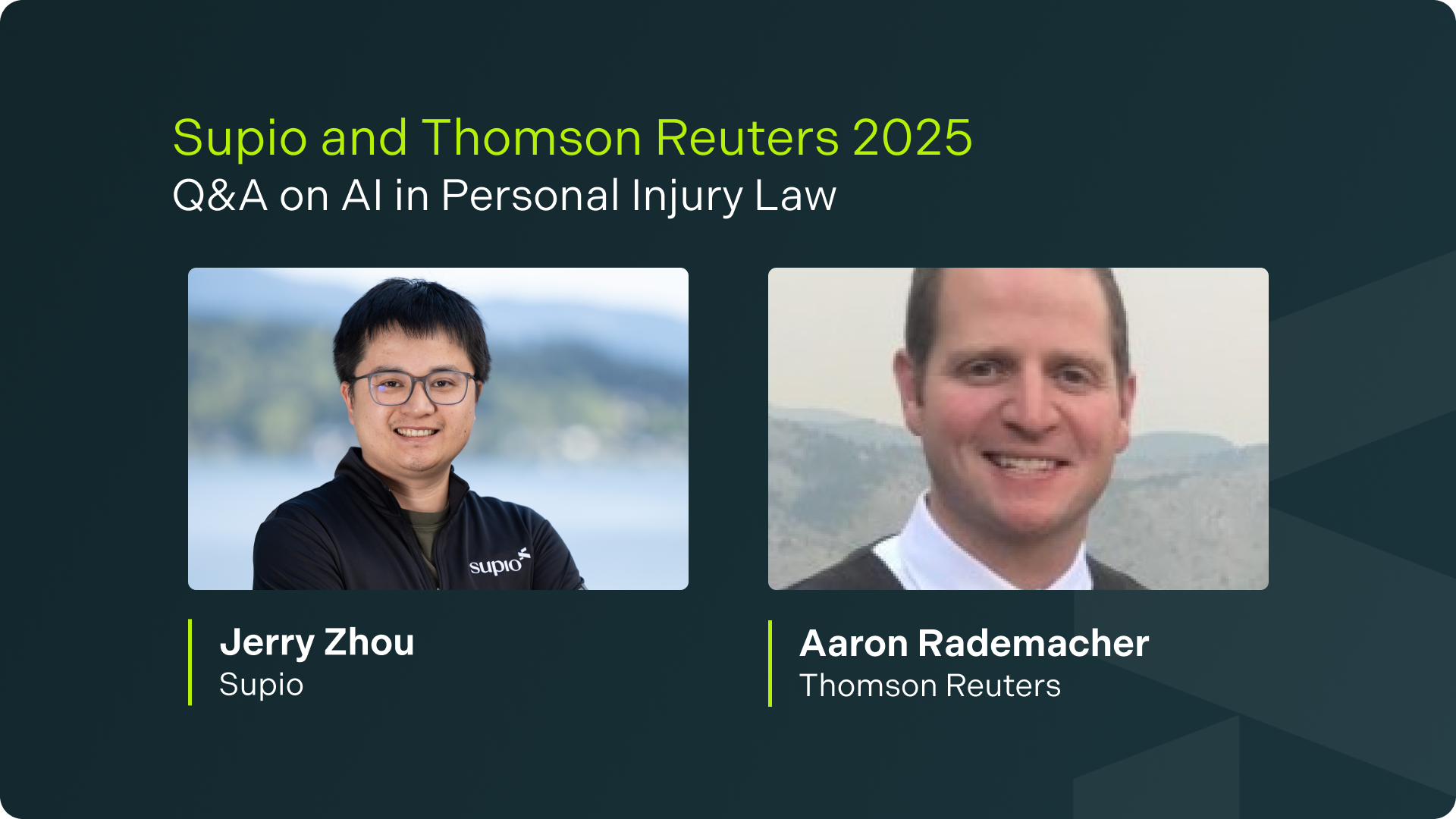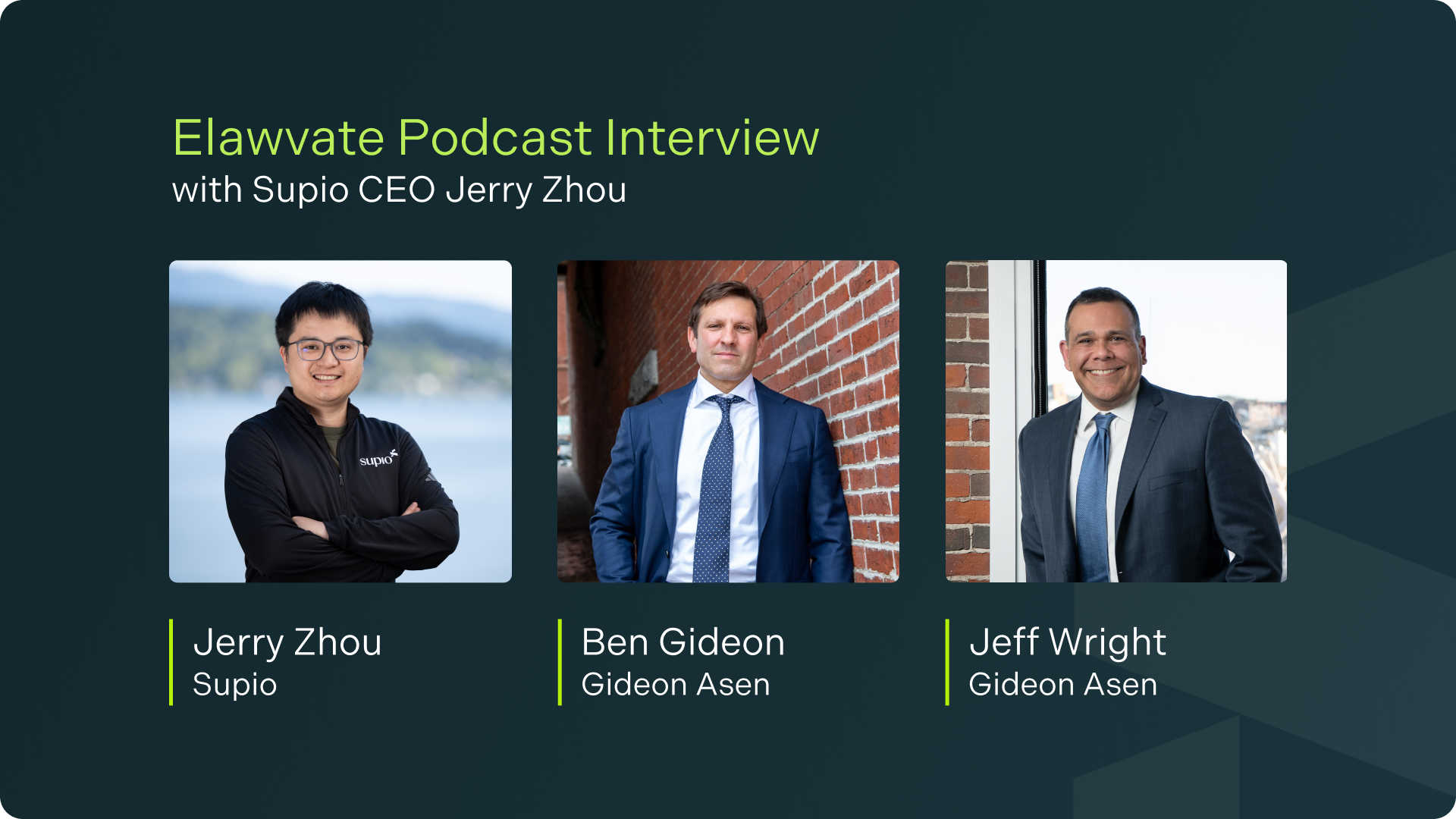Watch the full podcast episode on the Trial Lawyer View Podcast.
In this Q&A, Supio CEO Jerry Zhou and Thomson Reuters’ Aaron Rademacher explain how their partnership delivers legal AI tools for personal injury firms to level the playing field, improve outcomes, and reshape how plaintiff attorneys practice law.
Jason D. Lazarus (Host): Welcome to Trial Lawyer View. Today we’re live from the Supio Summit in New York. I’m joined by Jerry Zhou, CEO and Co-founder of Supio, and Aaron Rademacher, General Manager of Small Law at Thomson Reuters. Jerry, let’s start with you. Can you introduce yourself?
Jerry Zhou: I’m the co-founder and CEO of Supio. We’ve been building a plaintiff-attorney AI tool for about four years now, specifically designed to help firms through both pre-litigation and trial. We’re excited to be here today with the Thomson Reuters team.
Jason D. Lazarus: Thanks, Jerry. Aaron, how about you?
Aaron Rademacher: I’ve spent my entire career at Thomson Reuters (over 20 years now) and I currently serve as the General Manager of our Small Law segment. I lead a team of more than 260 employees dedicated to serving firms of fewer than ten attorneys, which make up the core of our customer base. My work is all about helping those smaller firms stay competitive through technology and strategy.
Jason D. Lazarus: Let’s zoom out. AI is at the forefront of almost every conversation in business right now. Jerry, from your perspective, why is this moment in legal practice so significant?
Jerry Zhou: For decades, computers were great at crunching numbers but struggled to automate language and concepts, the very material lawyers work with every day. With the rise of large language models and generative AI, that’s changed. For the first time, we can process legal concepts at scale. For attorneys, that means tasks that used to take weeks (like combing through records or drafting complex documents) can now be done in hours. It’s a fundamental shift, especially for personal injury law, which generates massive volumes of data in every case.
How does AI level the playing field for plaintiff attorneys?
Jason D. Lazarus: One of the themes we’ve heard at this Summit is how uneven the playing field can be for plaintiff lawyers. Defense firms often come armed with deeper resources and more advanced technology. Jerry, how do you see AI changing that dynamic?
Jerry Zhou: It really is a David versus Goliath story. Defense teams are backed by organizations with billion-dollar market caps, operating on the billable hour. Their job, frankly, is often to slow things down for plaintiffs and their clients. On the plaintiff side, firms are usually smaller and working on contingency.
What AI does is level that playing field. Information is no longer the bottleneck. Discovery, analyzing the data in a case, or drafting settlement packages are all processes that can now be accelerated. Instead of spending months just organizing records, attorneys can focus on strategy.
Jason D. Lazarus: So it’s not just about efficiency, it’s about giving smaller firms a chance to compete on equal footing.
Jerry Zhou: Exactly. The biggest risk for a small firm isn’t necessarily talent, it’s capacity. If you suddenly take on a complex case, your resources are tied up and you can’t scale beyond that. With AI, firms can handle more cases simultaneously without adding payroll. It allows attorneys to practice at a higher level, focus on strategy, and deliver justice faster for their clients.
What is the Supio × Thomson Reuters partnership about?
Jason D. Lazarus: Jerry, can you share why this partnership with Supio & Thomson Reuters is significant?
Jerry Zhou: When we were in our last fundraising round, we were connected with Thomson Reuters, and it became clear right away that the fit was natural. Thomson Reuters has tremendous reach within the legal community. By partnering, we can deliver Supio’s specialized AI solutions directly to more of the firms that need them. Beyond reach, we’re also working on product integration so that together we can build out more seamless, end-to-end solutions for attorneys.
Jason D. Lazarus: Aaron, from the Thomson Reuters side, why Supio? What made this partnership stand out?
Aaron Rademacher: For us, everything starts with the customer. We’re obsessed with delivering trusted, innovative, and accurate AI solutions to the market. Our horizontal platform, CoCounsel AI, is designed to serve attorneys across every practice area, anchored in the gold standard of legal research. But we also know clients want complete, end-to-end solutions tailored to their workflows.
Supio brings exactly that specialization in personal injury. By partnering, we’re able to complement our core platform with Supio’s depth in PI – helping small firms compete more effectively, become more efficient, and focus on what matters most: serving their clients.
At the end of the day, our shared goal is to help attorneys spend more time on strategy and creativity (the very reasons they became lawyers in the first place) while technology takes care of the administrative and repetitive work.
How can AI improve outcomes for injured clients?
Jason D. Lazarus: We’ve talked about what this means for firms, but ultimately, it’s the injured party who matters most. How does AI change the outcomes for clients themselves?
Jerry Zhou: The impact is real. On the financial side, when cases are documented and treated the right way, firms are able to present stronger demand packages. What we’ve seen is that those packages often lead to over 30% higher initial tenders at policy limits compared to traditional workflows.
See how Lundy Law 3x’d demand pack output with Supio →
Just as important is time-on-desk. A case that might have taken more than a year to resolve is now closing in under eight months. That makes a huge difference for clients who are waiting on settlements, often while bills and liens are piling up.
This is why I sometimes call it “AI with a heart.” By reducing the paperwork burden, attorneys can spend more time with their clients guiding them through one of the hardest periods of their lives and advocating for them in a more personal way.
What makes Supio’s legal AI tools different from other legal AI products?
Jason D. Lazarus: Jerry, there are plenty of AI products entering the legal space right now. How is Supio different from the rest?
Jerry Zhou: From the beginning, we realized it’s all about the data. Plaintiff attorneys generate and manage an enormous amount of it. By being data-first, we unlock workflows that simply weren’t possible before.
At the core is our single AI engine, CaseAware AI™. That engine powers dozens of workflows, from analyzing medical malpractice cases to organizing deposition transcripts. Because everything runs through one engine, improvements compound across use cases, and the value we deliver grows exponentially.
We’ve also built Supio Prism, which solves the breadth problem. Take mass torts: a single client may qualify for multiple types of litigation. Prism processes those datasets at scale, helping firms identify eligibility across tens of thousands of clients.
On the depth side, our deep research agent can now pinpoint weaknesses in a case at a level that wasn’t possible even a few months ago. For example, it can zero in on a single patient note or a passage in a deposition that might shift the entire case strategy.
Then there are the new tools:
- Case Economics: breaking down the line items between liens and medical bills so firms can cut through one of the most frustrating bottlenecks in PI work.
- Live deposition tools: real-time support during depositions, surfacing contradictions and helping attorneys steer questioning on the spot.
- Autonomous voice agents: handling the work no one enjoys, like sitting on hold with insurers, registering claims, or scheduling with adjusters.
All of this lets firms shift their energy back to what they actually care about: serving their clients, building strategy, and practicing law at the highest level.
How does Supio address AI hallucinations and accuracy concerns?
Jason D. Lazarus: One challenge we keep hearing about with generative AI is hallucinations (incorrect or fabricated outputs). How are you addressing that?
Jerry Zhou: First, it’s important to distinguish between two things: Supio focuses on understanding case data, while Thomson Reuters is the expert in legal research and precedent. That’s why our partnership is so valuable.
On the case-data side, we employ human-in-the-loop validation with subject-matter experts who review the outputs. We’ve built evaluation frameworks to measure AI performance against human benchmarks, and every time we update the models, we know exactly where they’re excelling and where they need guardrails.
We also design the product to make validation easier for attorneys. Everything from inline citations to warnings when a prompt might produce unreliable output. It’s about giving users control and transparency so they can trust what’s in front of them.
Aaron Rademacher: I’ll add that even as AI becomes more agentic – actually producing professional work product – human validation remains essential. It’s not enough to generate an answer. You need tools and workflows that let attorneys check and verify that work.
That’s why ethics, security, and ongoing guidance from the courts are so central to our approach. Generative AI isn’t about removing lawyers from the loop. It’s about giving them better ways to do their jobs while still exercising professional judgment.
What’s the best way for small law firms to adopt AI?
Jason D. Lazarus: Aaron, you’re in constant contact with small firms across the country. What are you seeing when it comes to AI adoption, and what advice do you give firms that are just getting started?
Aaron Rademacher: The adoption curve has accelerated dramatically. In the past year alone, the number of attorneys using AI daily is up nearly fourfold. But there’s an important catch: about 40% of those adopters don’t yet have a defined strategy for how they’re using it.
What we’ve found is that the benefits are exponentially higher when you do have a strategy. Firms that set intentional goals see about four times the efficiency gains and roughly double the revenue impact compared to those just experimenting without a plan.
So our advice is to start by identifying two pain points in your practice like the tasks you dislike or that slow you down the most. Focus your AI adoption on those areas first. That keeps it manageable and ensures you see a clear ROI quickly.
And there’s another layer that often gets overlooked: quality of life. In our surveys, about half of lawyers said their top hope for AI is simply more time with family, for themselves, or for higher-value work. AI isn’t just about financial performance. It’s about making the practice of law more sustainable.
Where is AI in law heading over the next three years?
Jason D. Lazarus: Let’s look ahead. Things are moving at a breakneck pace. Where do you see AI taking the legal profession in the next year or three?
Jerry Zhou: What excites me is the ability to surface insights that attorneys might otherwise miss. Take a traumatic brain injury in a motor vehicle case. Symptoms often aren’t obvious at first and can unfold over time. Because Supio processes tens of thousands of cases, the system can recognize those subtle patterns and flag them for the attorney. That could be life-changing for a client whose injuries might otherwise go unnoticed.
As we keep evolving, the next step is moving from insights to autonomy. Imagine an AI system that not only highlights risks and opportunities but also proactively optimizes settlements, identifies insurance coverage details, and guides treatment strategies. We’re not there yet, but the building blocks are in place.
Aaron Rademacher: I’d echo Jerry’s point. This transformation isn’t predetermined. We’re all building it as we go. At Thomson Reuters, we’ve seen the arc unfold like this:
- First, AI was just helpful, driving small efficiencies.
- Now, with agentic systems, it’s productive, creating real work product.
- Next, it will become proactive, surfacing issues before a lawyer even asks.
And eventually, we’ll see elements of autonomous practice.
What that means for attorneys is a new skill set: the ability to delegate effectively to AI. It’s not just “can you use the tool,” but “can you train and guide it to produce the work you need.” That’s going to redefine what it means to be a litigator.
At the same time, validation remains non-negotiable. Even as these systems get smarter, lawyers will need to verify outputs, apply ethical standards, and bring their judgment to the table. That balance between automation and human expertise is what will shape the next era of legal practice.
Final thoughts: Why does this partnership matter?
Jason D. Lazarus: We’ve covered a lot today from leveling the playing field to case outcomes, partnerships, and the future of the profession. Jerry, any final thoughts?
Jerry Zhou: For us at Supio, today’s conversation is a milestone. We’re constantly building and executing, but events like the Summit force us to step back, articulate our vision, and release the new technology we’ve been developing like our latest AI-powered case tools.
What keeps us grounded is the same thing we started with: delivering tangible value to plaintiff attorneys and their clients. We want to make sure every new tool solves a real bottleneck, whether it’s lien management, deposition prep, or client communication. At the end of the day, AI should let lawyers focus more on advocacy and less on paperwork.
Jason D. Lazarus: And if someone wants to learn more about Supio?
Jerry Zhou: The best place is our website at supio.com. You can also connect directly with one of our regional reps. We’d love to be your partner and shepherd you into this new era of AI.
Jason D. Lazarus: Jerry, Aaron, thank you both for your time. And thanks to everyone for tuning in to Trial Lawyer View, brought to you by Synergy.





